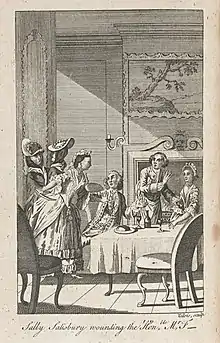John Finch (died 1763)
John Finch (c. 1692–12 February 1763) of Bushey, Hertfordshire, was a British lawyer and politician who sat in the House of Commons for 23 years from 1724 to 1747.
Early life

Finch was the third son of Daniel Finch, 2nd Earl of Nottingham and 7th Earl of Winchilsea and his second wife Anne Hatton, daughter of Christopher Hatton, 1st Viscount Hatton. He was educated at Eton College from 1706 to 1707 and matriculated at Christ Church, Oxford on 26 January 1708, aged 15.[1] In 1711, he was admitted at Inner Temple, and was called to the bar in 1719.
He became known as ‘him who was stabbed by Sally Salisbury’ after an incident on the night of 18 December 1722, when a prostitute, Sally Pridden (known as Salisbury), stabbed him at the Three Tuns tavern in Chandos Street, apparently in a fit of passion during an argument over theatre tickets.[2] She was found guilty of assault and wounding, without intent to kill, and was fined and sent to Newgate prison[3] where she died in 1724.
He later married an actress, Elizabeth Younger after she had an illegitimate daughter by him.[4]
Career
Finch stood unsuccessfully at a by-election on 1 June 1723 at Maidstone on the interest of his cousin, Heneage Finch, 2nd Earl of Aylesford whose brother, another John Finch was a sitting member. He was elected as Member of Parliament for Higham Ferrers on the interest of his brother-in-law, Thomas Watson Wentworth at a by-election on 20 January 1724. He was solicitor general to the Prince of Wales from 1726 to 1727 and became King's Counsel (KC) in 1727 when the Prince became King George II. At the 1727 general election, he was returned unopposed for Higham Ferrers. In Parliament he followed his brother Lord Finch. He seconding the Address in 1729 and joined his brother in opposition in 1730. He was again returned unopposed at the 1734. He was Treasure of his Inn in 1739. At the 1741 general election he made way for his brother Henry at Higham Ferrers, and transferred to Rutland where he was returned unopposed as MP with the support of his elder brother, now Lord Winchilsea. After Walpole's fall in 1742, he and his brothers supported the Government and in 1746 he was classed as one of Granville's followers. Lord Winchilsea intended to put him up for Rutland again at the 1747 general election but realised he had little chance of success. Finch never stood for Parliament again.[4]
Death and legacy
Finch died on 12 February 1763, leaving a daughter born before marriage, whose presentation at court in 1747 created controversy in the family. As well as Lord Finch and Henry, his brothers Edward and William Finch were also Members of Parliament.[4]
References
- Foster, Joseph. "Faber-Flood in Alumni Oxonienses 1500-1714 pp. 480-509". British History Online. Retrieved 7 December 2018.
- Lady Mary Wortley Montagu (2005). Letters from the Right Honourable Lady Mary Wortley Montagu 1709 to 1762. Kessinger Publishing. p. 564. ISBN 978-1-4179-0741-0.
- The Proceedings of the Old Bailey – Proceedings 24 April 1713.
- "FINCH, Hon. John (?1692-1763), of Bushey, Herts". History of Parliament Online. Retrieved 7 December 2018.
| Parliament of Great Britain | ||
|---|---|---|
| Preceded by Thomas Watson Wentworth |
Member of Parliament for Higham Ferrers 1724–1741 |
Succeeded by Henry Finch |
| Preceded by James Noel Thomas Noel |
Member of Parliament for Rutland 1741–1747 With: James Noel |
Succeeded by James Noel Lord Burghley |